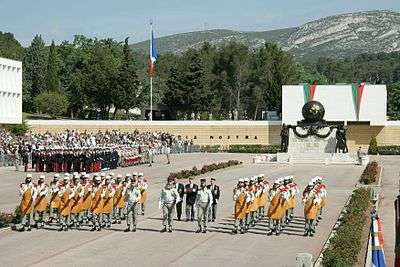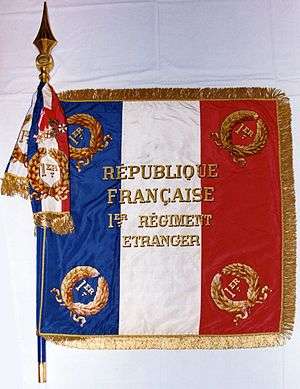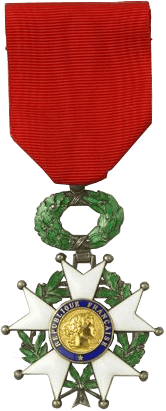Foreign Legion Pioneers (Pionniers)
| Foreign Legion Pioneers - (English) Pionniers de la Légion étrangère - (French) | |
|---|---|
|
Pionniers of the 1st Foreign Regiment | |
| Active | 1831 - Present |
| Country |
|
| Allegiance |
|
| Garrison/HQ | Aubagne, France |
| Nickname(s) | Pionniers |
| Motto(s) | Honneur et Fidélité |
| Colors | Green and Red |
| March |
Nous sommes tous des volontaires (We are all volunteers) |
| Anniversaries | Camerone 1863 |
| Battle honours | Camerone 1863 |
| Commanders | |
| Commandant de La Légion Etrangère (France) Commandant of the French Foreign Legion (English) | Foreign Legion Command[1] |
| Ceremonial chief | The Sous-Officiers |
| Notable commanders | Paul-Frédéric Rollet |

The Pioneers of the French Foreign Legion (French: Pionniers de la Légion étrangère) form a unit of tradition. They lead and open legion parades during all honorific ceremonies of arms and wear beards, buffalo leather aprons (French: tablier de buffle), and arm resting axes on their shoulders.
The unit is considered the only of its kind and type in service within the French Army and France.
History of the Pionniers
Early in the XVIII century; small pionnier units, the axemen soldiers in the Grenadier combat companies see action in the corps regiments serving the French Royal Army.[2] Their mission then was to mount assaults at the head of all combat units in order to destroy the obstacles created by the enemy.
Following a rather aleatory presence under the French Revolution,[3] the pionniers reappear under the French Consulate, wearing hairy grenadier caps without the metallic plate. These units were dissolved in 1818 and recreated in 1822.[3]
The French Foreign Legion retook, since 1831, that tradition which is still an integral part till present days.
Unlike the Pionniers of the Foreign Legion; the remainder of Pioneer units in the French Army were dissolved under the French Third Republic.
Pionniers of Tradition
In 1920 and 1921, two sapper combat companies of pionniers were created at the corps of the four foreign legion regiments operating in Morocco.[3] These units are tasked with engineering functions, mainly in terms of infrastructures (construction of roads, bridges, tunnels). These units did not carry any axes, however, they wore the insignia of tradition of the pionniers.
On April 30, 1931, during the 100th year celebration of the French Foreign Legion, orchestrated by general Paul-Frédéric Rollet, a section (platoon) of the sapper combat company of the 3rd Foreign Infantry Regiment paraded at the head of all parading troops while bearing the attributes of the pionniers, retaking the traditions of their predecessors.
Pionnier units were integrated officially within the ranks of tradition in 1946 by colonel Louis-Antoine Gaultier.[3]
Function of Tradition
Certain regiments of the French Foreign Legion (1e R.E., 2e R.E.G, 3e R.E.I, 4e R.E., D.L.E.M) house even, punctually or permanently, groups of pionniers (in general, one Sous-Officiers and 9 Legionnaires); however, the section of tradition is part of the 1st Foreign Regiment of Aubagne and is composed of 3 Sous-Officiers and 36 Legionnaires.
This section (platoon) of pionniers of the 1st Foreign Regiment is the one that opens the way for the Legion heading the 14th of July military parade on the Champs-Élysées in Paris. The same section of pionniers is also employed during the commemoration ceremony of the Battle of Camarón, on April 30, at the 1st Foreign Regiment to frame protect the holder of the wooden hand of captain Jean Danjou.
Honoring the Legion Sous-Officiers
Military parades of the Foreign Legion are headed and opened by this section to maintain the tradition of sapeurs opening and clearing the way (French: ouvrant la route), always at the front, amongst worth and honor. Such is the custom of honoring the Legion Sous-officiers (Majors, Adjudant-chefs and Adjudants) since one of them always parades at the head of all French Foreign Legion regimental parades of France.
Uniform of Tradition
The Pionniers distinguish themselves by their specific and unique uniform :
- Axe (French: Hache): serves to destroy obstacles of wood dressed by the enemy. At origin there were 6 kinds of axes to destroy and 7 kinds of axes to hammer.[3]
- Leather Apron (French: Tablier de Cuir): the apron initially served the function to protect the sapeurs from wooden munitions blasts while also limiting risks of penetration on obstacles in case of fall. The apron is of a tawny color.
- Gauntlet Gloves (French: Gants à Crispin ): White Gauntlet Gloves served to protect the hands while destroying obstacles.
- Beard (French: Barbe): Since the pionniers were the first to mount combat assaults, their life expectancy was very minimal. Accordingly from that principle, they reserved the right, when deploying to combat, to not shave and would come back bearded when they survived. The wearing of the beard became mandatory in the French Foreign Legion in 1844.[3]
- Pionniers Insignia (French: l'insigne de manche): Worn underneath the rank insignia on the right arm. The inisgnia represents two crossed axes, emblem of function of tradition. The losanges (diamonds) vary in color and depend on ranks:
- Golden Axe on uni black background for Sous-officiers.
- Golden Axe on black background bordered with gold for the Caporaux-Chefs.
- Green Axe on black background bordered with green for the Caporaux and Legionnaires.
Tradition
Insignia
<gallery = "mode packed">
File:Insigne 1er régiment étranger-transparent.png|
File:Pionniers.png|Pionniers of the 1st Foreign Regiment
File:Insign de béret 1er RE Type 3.jpg|
</gallery>
Regimental Colors


Regimental Song
Chant de Marche : Nous sommes tous des volontaires featuring:[4]
Nous sommes tous des volontaires,
Les gars du 1er étranger,
Notre devise est légendaire,
Honneur Fidélité - Fidélité,
Marchons légionnaires,
Dans la boue, dans le sable brûlant, (bis)
Marchons l'âme légère, (bis)
Et le cœur vaillant, (bis)
Marchons légionnaires. (bis)
Nous marchons gaiement en cadence,
Malgré le vent malgré la pluie,
Les meilleurs soldats de la France,
Sont là devant vous, les voici.
Partout où le combat fait rage,
L'on voit le 1er étranger,
Exemple d'héroïsme, de courage,
Se couvrir de glorieux lauriers.
Gardons dans le fond de nos âmes,
Le souvenir de nos aînés,
Et pour la grenade à sept flammes,
Loyal prêt à tout sacrifier.
Decorations
- Legion of Honour on April 28, 1906
- Croix de guerre 1939–1945 (France) with 1 palm[5]
- Gold Medal of the City of Milan since March 9, 1909
- Cross with swords of the Sovereign Military Order of Malta
-

Legion of Honour -

Croix de guerre 1939-1945 with 1 palm
Honors
Battle honours
- Sevastopol 1855[5]
- Kabilie 1857
- Magenta 1859
- Camerone 1863
- Extrême-Orient 1884-1885
- Dahomy-Maroc 1892-1907, 1925
- Madagascar 1895-1905
- Orient 1915-17
- AFN 1952-1962
Gallery
-

Pionniers during 1970.
See also
- 6th Foreign Infantry Regiment
- 6th Foreign Engineer Regiment
- 1st Foreign Engineer Regiment
- 2nd Foreign Engineer Regiment
References
- ↑ Official Website of the Commandement de la Légion Etrangère
- ↑ Decree of January 10, 1747 created, created 10 axemen soldiers integrated in each grenadier combat company
- 1 2 3 4 5 6 général (cr) Jean Hallo, Monsieur légionnaire, Lavauzelle, 2000, ISBN 978-2702503706
- ↑ Official Website of the 1st Foreign Regiment, Chant du 1er Régiment étranger
- 1 2 Official Website of the 1st Foreign Regiment, Regimental Colors and decorations


